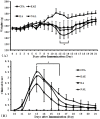The mechanism of effective electroacupuncture on T cell response in rats with experimental autoimmune encephalomyelitis
- PMID: 23382807
- PMCID: PMC3557272
- DOI: 10.1371/journal.pone.0051573
The mechanism of effective electroacupuncture on T cell response in rats with experimental autoimmune encephalomyelitis
Abstract
Previously, we demonstrated that electroacupuncture (EA) decreased lymphocyte infiltration into the spinal cords of rats presenting with experimental autoimmune encephalomyelitis (EAE), a disease model used in the study of multiple sclerosis (MS). The aim of this study was to characterize the effects of EA on the EAE. Female Lewis rats were divided into either CFA, EAE, EA, or injection with naloxone after electroacupuncture (NAL) groups. Electroacupuncture was administered every day for 21 days. To evaluate proliferation and apoptosis, lymphocytes from rats presenting with EAE were collected and cultured with β-endorphin. Immunohistochemisty, flow cytometry and radio-immunity methods were applied to detect the expression of β-endorphin. Results presented in this report demonstrate that the beneficial anti-inflammatory effects of EA on EAE were related to β-endorphin production that balances the Thl/Th2 and Th17/Treg responses. These results suggest that β-endorphin could be an important component in the development of EA-based therapies used for the treatment of EAE.
Conflict of interest statement
Figures









Similar articles
-
Involvement of microRNA-155 in the mechanism of electroacupuncture treatment effects on experimental autoimmune encephalomyelitis.Int Immunopharmacol. 2021 Aug;97:107811. doi: 10.1016/j.intimp.2021.107811. Epub 2021 Jun 3. Int Immunopharmacol. 2021. PMID: 34091117
-
The effect of electroacupuncture on T cell responses in rats with experimental autoimmune encephalitis.J Neuroimmunol. 2010 Mar 30;220(1-2):25-33. doi: 10.1016/j.jneuroim.2009.12.005. Epub 2010 Feb 1. J Neuroimmunol. 2010. PMID: 20117842
-
Bifidobacterium animalis in combination with human origin of Lactobacillus plantarum ameliorate neuroinflammation in experimental model of multiple sclerosis by altering CD4+ T cell subset balance.Biomed Pharmacother. 2017 Nov;95:1535-1548. doi: 10.1016/j.biopha.2017.08.117. Epub 2017 Sep 22. Biomed Pharmacother. 2017. PMID: 28946394
-
Adipose-derived mesenchymal stem cells modulate the immune response in chronic experimental autoimmune encephalomyelitis model.IUBMB Life. 2016 Feb;68(2):106-15. doi: 10.1002/iub.1469. Epub 2016 Jan 12. IUBMB Life. 2016. PMID: 26757144 Review.
-
Neuroinflammation at single cell level: What is new?J Leukoc Biol. 2020 Oct;108(4):1129-1137. doi: 10.1002/JLB.3MR0620-035R. Epub 2020 Aug 10. J Leukoc Biol. 2020. PMID: 32779279 Review.
Cited by
-
Electro-acupuncture at Acupoint ST36 Ameliorates Inflammation and Regulates Th1/Th2 Balance in Delayed-Type Hypersensitivity.Inflammation. 2017 Apr;40(2):422-434. doi: 10.1007/s10753-016-0487-z. Inflammation. 2017. PMID: 27966183
-
Electro-Acupuncture at Zusanli Acupoint (ST36) Suppresses Inflammation in Allergic Contact Dermatitis Via Triggering Local IL-10 Production and Inhibiting p38 MAPK Activation.Inflammation. 2017 Aug;40(4):1351-1364. doi: 10.1007/s10753-017-0578-5. Inflammation. 2017. PMID: 28493082
-
Moxibustion and Acupuncture Ameliorate Crohn's Disease by Regulating the Balance between Th17 and Treg Cells in the Intestinal Mucosa.Evid Based Complement Alternat Med. 2015;2015:938054. doi: 10.1155/2015/938054. Epub 2015 Aug 4. Evid Based Complement Alternat Med. 2015. PMID: 26347488 Free PMC article.
-
Electroacupuncture Promotes Remyelination after Cuprizone Treatment by Enhancing Myelin Debris Clearance.Front Neurosci. 2017 Jan 10;10:613. doi: 10.3389/fnins.2016.00613. eCollection 2016. Front Neurosci. 2017. PMID: 28119561 Free PMC article.
-
Mechanism underlying treatment of ischemic stroke using acupuncture: transmission and regulation.Neural Regen Res. 2021 May;16(5):944-954. doi: 10.4103/1673-5374.297061. Neural Regen Res. 2021. PMID: 33229734 Free PMC article. Review.
References
-
- Gironi M, Martinelli V, Brambilla E, Furlan R, Panerai AE, et al. (2000) Beta-endorphin concentrations in peripheral blood mononuclear cells of patients with multiple sclerosis: effects of treatment with interferon beta. Arch Neurol 57: 1178–1181. - PubMed
-
- Yoshino S, Koiwa M, Shiga H, Nakamura H, Higaki M, et al. (1992) Miyasaka N. Detection of opioid peptides in synovial tissues of patients with rheumatoid arthritis. J Rhematol 19: 660–661. - PubMed
-
- Börner C, Warnick B, Smida M, Hartig R, Lindquist JA, et al. (2009) Mechanisms of opioid-mediated inhibition of human T cell receptor signaling. J Immunol. 183(2): 882–889. - PubMed
-
- Panerai AE, Sacerdote P (1997) Beta-endorphin in the immune system: a role at last? Immunol Today 18: 317–319. - PubMed
Publication types
MeSH terms
Substances
LinkOut - more resources
Full Text Sources
Other Literature Sources
Medical

